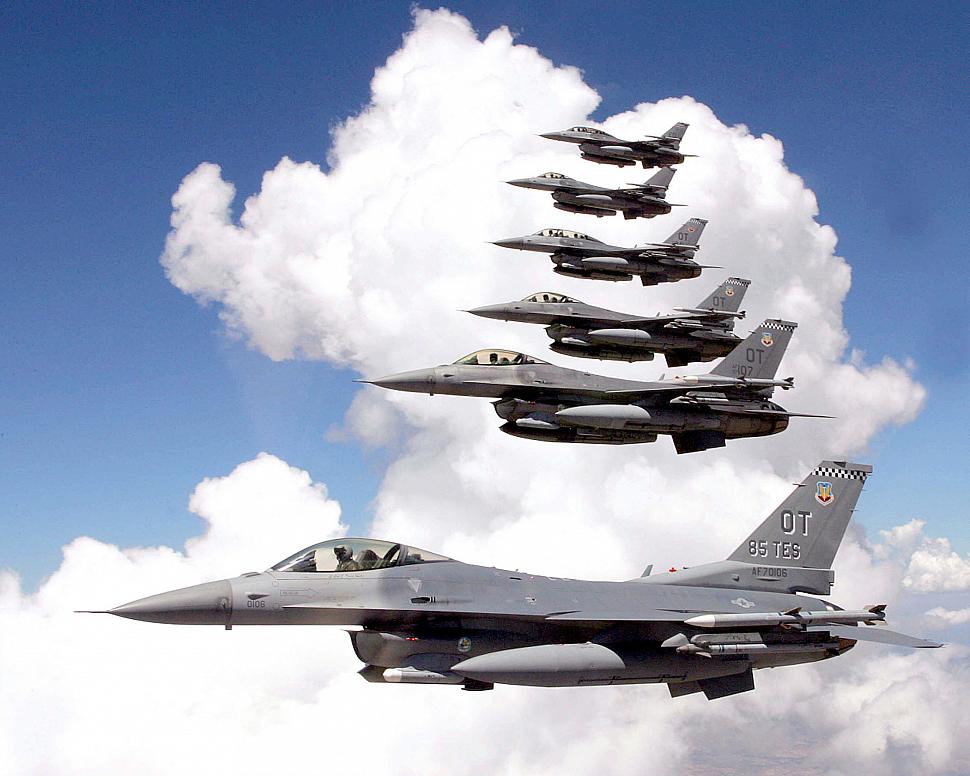Fighter Jet News
F-16 Fighting Falcon News
Edwards, Eglin combine testing on next-generation F-16
August 6, 2005 (by
Tech. Sgt. Eric M. Grill) -
Combining two aircraft missions into one is not an easy feat, but that is exactly what engineers and pilots from here and Eglin Air Force Base, Fla., are testing. In the process, they have also combined operational and developmental into one testing effort.
Five F-16 Fighting Falcons and aircrews from the 85th Test and Evaluation Squadron at Eglin deployed here July 22 to 29 and joined two 416th Flight Test Squadron F-16s to focus primarily on operationally testing the M4.2-plus core avionics suite upgrade to the F-16. Lessons learned from both types of testing will be applied to improve future versions of the upgrade.
The F-16 is a compact, multirole fighter aircraft designed to be highly maneuverable in air-to-air combat and air-to-surface attack. There are several versions of the F-16 used by the United States, including the block 40 and block 50.
The Block 40 F-16 primary mission fills the air-to-surface attack role, while the Block 50’s primary mission is destruction and suppression of enemy air defenses.
The M4.2-plus avionics upgrade combines both combat roles into a single fighter aircraft. The upgrade is being completed using spiral development, meaning all program stakeholders, including developmental testers, contractors and operational units work together early in the process to ensure testing is conducted more efficiently. This helps align operational objectives and is geared toward providing mature, stable systems to the warfighter as quickly as possible.
"The M4.2-plus upgrade achieves the goal of the Air Force's F-16 Common Configuration Implementation Program to support common aircraft equipment and core avionics software capabilities," said Shauna Urwiller, Global Power Fighters program manager from the 416th FLTS.
Testing included evaluation of the weapons systems, hardware improvements on the multifunctional information distribution system and a look at the latest radar detection technologies, she said.
"This is the F-16 we've been waiting for," said Lt. Col. J. Todd Hicks, 85th TES commander. "When I first started flying (F-16s) we had free-falling munitions and limited air-to-air (combat) capability. It's been an evolution of more than 20 years to be able to execute all tactical combat missions, ranging from precision engagement to suppression of enemy air defenses to air superiority. The F-16 continues to be the world's premier multi-role fighter."
Aircrews from the 85th TES and visiting people with the 422nd Test and Evaluation Squadron from Nellis AFB, Nev., evaluated the current F-16 M4.2-plus avionics suite during operationally representative SEAD engagements at the Air Force Flight Test Center.
"Combined operational and developmental testing is intended to exercise the avionics and new hardware components to include the high-speed anti-radiation missile-targeting system in operational scenarios," said Capt. Brian Griffin, M4.2-plus program flight test engineer for the 416th FLTS.
Aircrews also evaluated the pilot vehicle interface of avionics systems to include mechanization, systems degradation and operational suitability, he said.
When the final spiral is rolled out, in about two years, and then fully implemented operationally, Colonel Hicks said it will give combatant commanders the capability to use one F-16 that can carry out the mission of two.
The F-16 is a compact, multirole fighter aircraft designed to be highly maneuverable in air-to-air combat and air-to-surface attack. There are several versions of the F-16 used by the United States, including the block 40 and block 50.
The Block 40 F-16 primary mission fills the air-to-surface attack role, while the Block 50’s primary mission is destruction and suppression of enemy air defenses.
The M4.2-plus avionics upgrade combines both combat roles into a single fighter aircraft. The upgrade is being completed using spiral development, meaning all program stakeholders, including developmental testers, contractors and operational units work together early in the process to ensure testing is conducted more efficiently. This helps align operational objectives and is geared toward providing mature, stable systems to the warfighter as quickly as possible.
"The M4.2-plus upgrade achieves the goal of the Air Force's F-16 Common Configuration Implementation Program to support common aircraft equipment and core avionics software capabilities," said Shauna Urwiller, Global Power Fighters program manager from the 416th FLTS.
Testing included evaluation of the weapons systems, hardware improvements on the multifunctional information distribution system and a look at the latest radar detection technologies, she said.
"This is the F-16 we've been waiting for," said Lt. Col. J. Todd Hicks, 85th TES commander. "When I first started flying (F-16s) we had free-falling munitions and limited air-to-air (combat) capability. It's been an evolution of more than 20 years to be able to execute all tactical combat missions, ranging from precision engagement to suppression of enemy air defenses to air superiority. The F-16 continues to be the world's premier multi-role fighter."
Aircrews from the 85th TES and visiting people with the 422nd Test and Evaluation Squadron from Nellis AFB, Nev., evaluated the current F-16 M4.2-plus avionics suite during operationally representative SEAD engagements at the Air Force Flight Test Center.
"Combined operational and developmental testing is intended to exercise the avionics and new hardware components to include the high-speed anti-radiation missile-targeting system in operational scenarios," said Capt. Brian Griffin, M4.2-plus program flight test engineer for the 416th FLTS.
Aircrews also evaluated the pilot vehicle interface of avionics systems to include mechanization, systems degradation and operational suitability, he said.
When the final spiral is rolled out, in about two years, and then fully implemented operationally, Colonel Hicks said it will give combatant commanders the capability to use one F-16 that can carry out the mission of two.
Courtesy of Air Force Material Command News Service
Related articles:
Tags
Tags

